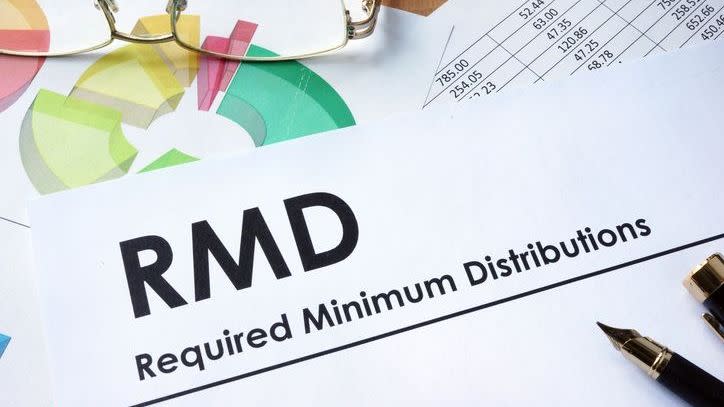
Converting a 401(k) to a Roth IRA is attractive for several reasons. Not only can you make qualified withdrawals from Roth accounts tax-free, Roth accounts are also exempt from required minimum distributions (RMDs), which gives you more flexibility when withdrawing from your account during retirement and can save you money on taxes.
If you’re considering a Roth conversion or need help planning for your RMDs, consider working with a financial advisor.
Imagine you’re nearing retirement age and have $1.3 million in a 401(k). Transferring the entire balance at once leaves you with a huge tax liability. On the other hand, rolling over your 401(k) gradually over a decade can reduce taxes more than rolling over it all in one transaction.
Although you can start rolling over $130,000 a year, you may want to roll over that amount later depending on how the investments in your 401(k) perform.
Effect of Roth Conversions on RMDs

Withdrawals of RMDs you should take from tax-deferred retirement accounts starting at age 73 (RMD age increases to 75 for anyone turning 74 after December 31, 2032). These withdrawals are treated as ordinary taxable income, so RMDs can push you into a higher tax bracket and increase your tax bill.
For example, if you have $1.3 million in your 401(k) at age 59 and earn 4% annually for the next 14 years, your 401(k) will grow to more than $2.77 million.. When you start taking RMDs after you turn 73, your first RMD will be more than $104,000. If you’re a single filer with only $25,000 of taxable retirement income in Social Security benefits, that increases your marginal tax rate from 12% to 24% (using the 2024 tax brackets).
Avoiding RMDs isn’t the only reason to consider switching. You may also want to switch if you think you’ll be in a higher tax bracket after you retire. Also, Roth accounts can easily pass your wealth on to your heirs, so conversions are a useful estate planning tool. But if you need help deciding whether a Roth conversion is right for your situation and goals, talk it over with a financial advisor.
Conversion strategies
If you converted a lump sum of $1.3 million, this would put you in the highest marginal tax bracket – 37% – and owe more than $430,000 on your next tax return. Making a series of annual $130,000 conversions over the next 10 years will significantly reduce this tax bill.
Assuming for example that you have $60,000 in other taxable income each year after deductions and credits, your annual income during the conversion period would be $190,000. As a single filer, that puts you in the 24% bracket and paying about $35,000 a year in taxes (assuming you take the standard deduction). Over a 10-year exchange period you would hypothetically pay more than $350,000 in taxes, but save about $80,000 compared to a lump sum exchange.
In some cases, you can use other conversion strategies. For example, if you expect to have a lower income one year, you can transfer a larger amount. The main idea is to roll over enough of your 401(k) savings to bring your taxable income up to the next tax bracket threshold — but not over it. If you’re interested in Roth conversions or other tax planning strategies, consider working with a financial advisor.
Roth conversion caveats

Moving 401(k) funds into a Roth account makes financial sense, but the move has some risks and limitations. To begin with, you must wait five years after establishing a Roth IRA to withdraw any investment income from the account. Violation of this rule will attract income taxes and 10% early withdrawal penalty.
There is also a special five-year waiting period that applies exclusively to Roth conversions. The IRS requires that you wait five years from the beginning of the year you completed the conversion before withdrawing any of the converted money. However, this special five-year rule does not apply to persons age 59 ½ or older.
If you set up your Roth now at age 59 and start taking withdrawals before you turn 64, you may have to pay taxes on some of the withdrawals.
Also, implementing a Roth conversion strategy requires making assumptions about future tax rates and the returns your investments will earn. There is risk in forecasting as events may turn out differently. For example, if you expect tax rates to be low in the future and they will increase, under current law, you’re better off changing now.
You may also want to convert more if your investments yield higher returns than expected. Your 401(k) may have more money than you expected when you complete your conversion plan, so you still need to take RMDs.
Finally, if you have any money left in your 401(k), don’t neglect to take mandatory RMDs. If you do, you will have to pay a penalty of 25% of the amount you should have withdrawn as an RMD. And remember, a financial advisor can help you plan for RMDs and their tax impact.
The bottom line
Moving funds from a 401(k) or other tax-deferred retirement account can help you avoid RMDs and reduce your tax liability. Gradual rollover of a portion of your 401(k) each year may make sense as a way to lower your current tax bill. However, you should be flexible about the amount you convert if tax rates or your investment returns change differently than you thought.
RMD planning tips
-
If you have tax-deferred retirement accounts, you should be aware of how much your RMDs may be and plan for their tax impact. It’s easy to calculate your RMDs on your own, but SmartAsset has created an RMD calculator to make it even easier. A free tool can help you estimate how much your first RMD will be and when to take it.
-
Deciding how to move funds from a 401(k) to a Roth account requires careful evaluation of your options. A financial advisor can help with that. Finding a financial advisor is not difficult. SmartAsset’s free tool matches you with up to three financial advisors serving your area, and you can make a free introductory call with your advisor matches to decide which one you think is right for you. If you’re ready to find an advisor to help you achieve your financial goals, start now.
Photo Credit: ©iStock.com/Luke Chan, ©iStock.com/designer491, ©iStock.com/kate_sept2004
The post I’m 59, With $1.3 Million in a 401(k) Should I convert $130,000 a year to a Roth to avoid RMDs? appeared first on SmartReads by SmartAsset.
#million #401k #convert #year #Roth #avoid #RMDs